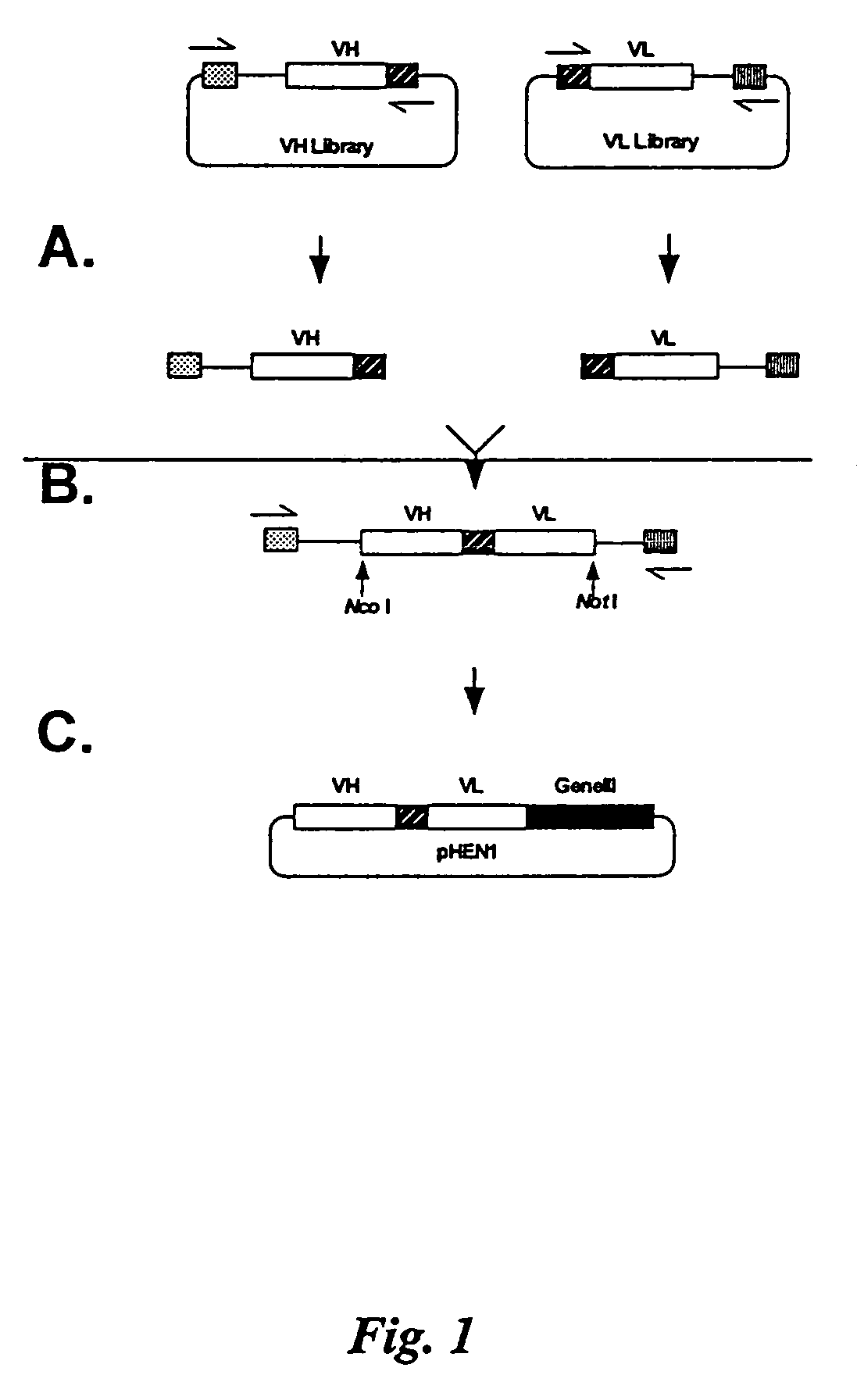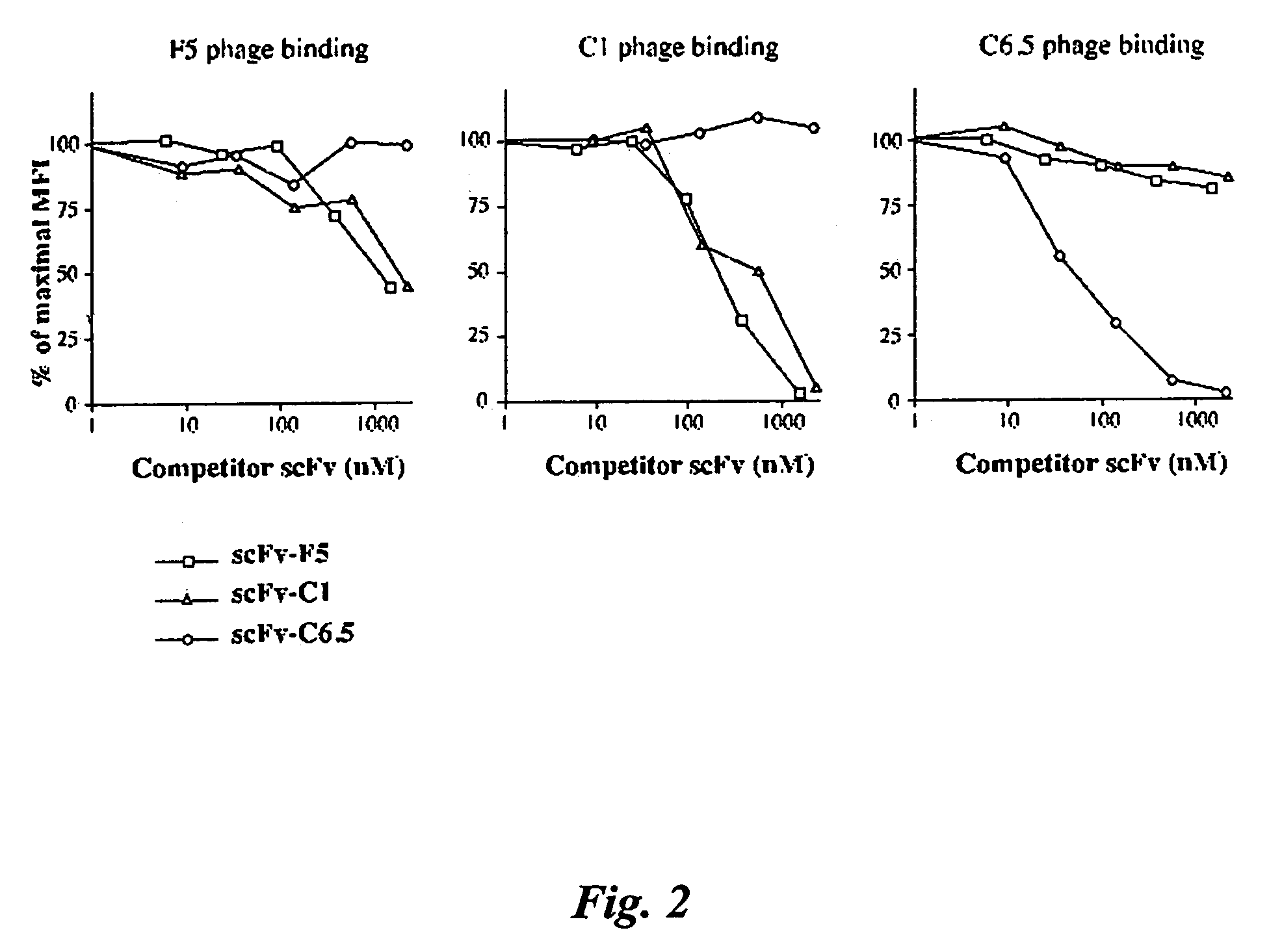Internalizing ERB2 antibodies
a technology of erb2 antibodies and antibodies, applied in the field of immunotherapy, can solve the problems of low binding affinity, limited success of antibodies used in the diagnosis and treatment of solid tumors, and hampered utility
- Summary
- Abstract
- Description
- Claims
- Application Information
AI Technical Summary
Benefits of technology
Problems solved by technology
Method used
Image
Examples
example 1
Creation of a Non-Immune Human Fab Phage Antibody Library Containing 109–1011 members
[0267]Manipulation of previous 107 member phage display libraries revealed two major limitations: 1) expression levels of Fabs was too low to produce adequate material for characterization, and 2) the library was relatively unstable. These limitations are a result of creating the library in a phage vector, and the use of the cre-lox recombination system. We therefore decided that the best approach for this project was to create a very large scFv library using a phagemid vector. The goal was to produce a library at least 100 times larger than our previous 3.0×107 member scFv library. The approach taken was to clone the VH and VL library on separate replicons, combine them into an scFv gene repertoire by splicing by overlap extension, and clone the scFv gene repertoire into the phage display vector pHEN1. Human peripheral blood lymphocyte and spleen RNA was primed with IgM heavy chain constant region ...
example 2
Uptake of scFV into Cells by Receptor Mediated Endocytosis and Subsequent Recovery
[0274]The 7.0×109 member scFv phage antibody library described above was selected on the malignant breast tumor cell lines MB231 and ZR-75–1, both with and without negative selections on the normal breast cell line HBL100. Similar results were obtained as described in section above. scFv were isolated that could not distinguish malignant from non-malignant cell lines.
[0275]To increase the specificity of selections, it was hypothesized that phage binding cell surface receptors could be taken up into cells by receptor mediated endocytosis and could then be recovered from cells by lysing the cells. This assumed: 1) that phage could be internalized by receptor mediated endocytosis and 2) that phage could be recovered in the infectious state from within cells prior to lysosomal degradation. The ability to select for internalized phage antibodies would have two major benefits: 1) the identification of antibo...
example 3
Increasing the Affinity of Antibody Fragments with the Desired Binding Characteristics by Creating Mutant Phage Antibody Libraries and Selecting on the Appropriate Breast Tumor Cell Line
[0291]Phage display has the potential to produce antibodies with affinities that cannot be produced using conventional hybridoma technology. Ultra high affinity human antibody fragments could result in excellent tumor penetration, prolonged tumor retention, and rapid clearance from the circulation, leading to high specificity. We therefore undertook a series of experiments to develop methodologies to generate ultra high affinity human antibody fragments. Experiments were performed to answer the following questions: 1) What is the most effective way to select and screen for rare higher affinity phage antibodies amidst a background of lower affinity binders; 2 What is the most effective means to remove bound phage from antigen, to ensure selection of the highest affinity phage antibodies; 3) What is th...
PUM
| Property | Measurement | Unit |
|---|---|---|
| Tm | aaaaa | aaaaa |
| pH | aaaaa | aaaaa |
| pH | aaaaa | aaaaa |
Abstract
Description
Claims
Application Information
 Login to View More
Login to View More - R&D
- Intellectual Property
- Life Sciences
- Materials
- Tech Scout
- Unparalleled Data Quality
- Higher Quality Content
- 60% Fewer Hallucinations
Browse by: Latest US Patents, China's latest patents, Technical Efficacy Thesaurus, Application Domain, Technology Topic, Popular Technical Reports.
© 2025 PatSnap. All rights reserved.Legal|Privacy policy|Modern Slavery Act Transparency Statement|Sitemap|About US| Contact US: help@patsnap.com


